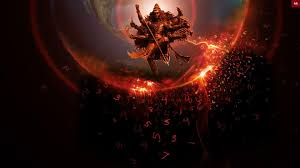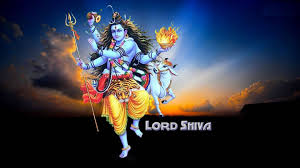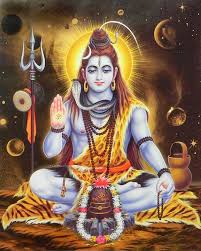No products in the cart.

Rudra Avatar of Lord Shiva is a well-known form of Shiva in Hindu Dharma. He is often associated with a mighty hurricane. Rudra literally means a tempest and is the term used by many as the other name of the entity Shiva, his most violent and furious form to be specific. He is one of the three celestial beings believed to have created the universe. Hindu scriptures like Vishnu Purana, Matsya Purana, and Bhagavad Gita use the word Rudra to coin the eleven forms of Shiva (Ekadasha-Rudras), brought to life to end the cruelty and tyranny of rakshasas on earth and heaven. Different scriptures have different origin stories of these Rudras.
Rudra is one of the most popular names of Shiva used extensively in the Vedas to refer to him. In fact, an expression addresses him as Rudra Shiva. The literal meaning of the term Rudra seems to be roaring storm. The other meanings associated with this word are fire and fiery red. Looking from several angles, the term Rudra appears to focus on the fiery aspect of Shiva which is destruction. A paagraph in Rudrashtakam describes the Rudra nature of Shiuva
Prachannddam Prakrssttam Pragalbham Paresham
Akhannddam Ajam bhaanu_Koti Prakasham
Tryah_Shoola Nirmoolanam Shoola paannim
Bhajeham Bhavaani _ patim ,Bhaava_gamyam
The meaning is: I bow to You Rudra , who is terrible , eminent amd extremely strong, who is the highest Lord. Who is ever Unborn and whole, and has the brightness of million Sun’s. Who has a trident in his hand, the three spikes of which uproots the bondages of the three gunas/qualities namely Tamas, Rajas and Sattva. I bow to you, the Husband of Devi Bhavaani , who can be attained by devotion.
Hindu theology talks of three principal manifestations of the Supreme Godhead namely Brahma the creator, Vishnu the protector and Shiva the destroyer. In this context, the fierce name of Rudra seems to be highly fitting the role of Lord Shiva. The term Rudra is also associated with the term Rudra Tandava, the dance of Shiva which he performs in the cremation grounds. The iconography of Shiva shows him wearing snakes as ornaments, a garland of skulls, the ashes of the cremation grounds smeared all over the body and wandering forth in red angry eyes.
A puranic story narrates an incident associated with the term Rudra. Once Brahma asked Rudra to create some beings as he was getting bored by creating ordinary mortals.Owing to this request, Shiva created 11 immortal beings who are called Kapali, Pingala, Bhima, Virupaksa, Vilohita, Ajesha, Shasana, Shasta, Shambhu, Chanda and Dhruva. They were together called as 11 Rudras.Being the head of these immortal beings, Shiva is addressed as Rudra. The hymns of Rg Veda have a lot of references to Shiva in the name Rudra. They all portray Shiva as the highest God, a mighty archer, the most terrible form, the fire god and so on. In all these expressions, the fiery aspect of Shiva is obvious.It is a matter for thought that the name Rudra is in sharp contrast to the name Shiva in terms of the meanings suggested by these words. While the term Rudra embodies in it a terrible aspect by denoting the roaring storm, the term Shiva points out to the benign aspect of Shiva. Thus, these two terms together bring the contrasting features of Shiva put in one expression.
The expression Rudra is extensively used in the Vedic hymn Rudram that is dedicated to singing the praise of Lord Shiva. The summary of this hymn heralds the different aspects of Lord Shiva and praises him as the supreme one who is the one point origin of the entire universe and everything associated with creation. Rudra is also conceived as the final destination of the entire universe in to which it merges back after dissolution.We can take that while the term Rudra points out to the role of Shiva namely destruction, the term Shiva points out to the benign nature of Shiva which is blessing the devotees with the boons that they want.Shiva is compassionate and merciful. Being the parent of the entire universe, he is endowed with the supreme role of taking care of their well-being. Chanting the name of Rudra shall invoke the blessings of Shiva and win his grace for the devotees.

The Origin of Rudra
Back in the days when Gods walked freely between the Heaven and the earth; when deities fought for justice and light, Indra, the god of thunder, ruled the deities in a city called Amrawati Puri. In one such battle, the rakshasas were able to defeat Indra and his army of gods and they forced Gods to flee from the city. The deities were full of fear and out of despair, they went to Maharishi Kashyap’s Ashram (a residence, also functioning as school). He happened to be the father of Indra.
In the meeting, the King of Gods, now dethroned, told the entire story to his father. Kashyap was furious at the deeds of the rakshasas. Maharishi was known for his supreme knowledge and his ability to meditate. Thus, He consoled the god and promised that he would find a solution to the problem.
Maharishi set off to Kashipuri with the motive to meditate and seek an audience with the celestial entity Shiva himself. After reaching Kashipuri, he established a Shiva-Linga (a cylindrical shaped shrine representing Shiva) and started to meditate in its presence, by chanting his name. After meditating for quite some time, Shiva appeared in front of him. He seemed impressed by Kashyap’s meditation and asked the Maharishi to make a wish.
Kashyap remembered the dire condition of the gods. He then told Shiva that the rakshasas had defeated the gods, and had taken over the city of Amrawati Puri. He asked Shiva to be born as his son, to offer justice to the gods and take the place in the city as their protector. Shiva granted his wish by uttering the words, “Tathastu!” (So be it). In ecstasy, Kashyap showed his piety to the entity, and he disappeared.
Maharishi returned to his ashram and explained the entire incident to the gods. They were pleased to hear everything. In time, Kashyap impregnated his wife, Surabhi, who then gave birth to 11 sons. These were the forms of the celestial entity Shiva and were known as Rudras. With their birth, the entire world, including the gods, Kashyap and his wife were pleased.

The 11 Rudras are:
- Kapali
- Pingala
- Bhima
- Virupaksha
- Vilohita
- Ajesha
- Shasana
- Shasta
- Shambu
- Chanda and
- Dhruva
Rudras in other Scriptures
In Matsya Puran, the Rudras were the children of Kashyap and Surabhi, like Shiva Puran. However, different names for the Rudras have been used. The 11 Rudras as per this text are Nirriti, Shambhu, Aparajita, Mrigavyadha, Kapardi, Dahana, Khara, Ahirabradhya, Kapali, Pingala and Senani.
In Vishnu Purana, quite contradictorily, the Rudras aren’t associated with Shiva, but Brahma (one of the three celestial entities believed to have created the universe). They’re said to have been created out of the rage of Brahma. The names of the Rudras according to this scripture were Manyu, Manu, Mahmasa, Mahan, Siva, Rtudhvaja, Ugraretas, Bhava, Kama, Vamadeva and Dhrtavrata.
Like any other deity or characters from an epic or ancient story, there exists ambiguity regarding the origin, names, and functions of these Rudras. However, it cannot be denied that they were fierce warriors forged to protect the Earth and the Gods and bring peace to the whole existence.

Shiva and Rudra
Shiva and Rudra are the two names of Hinduism‘s supreme deity. Siva is his benevolent manifestation, signifies everything that is good. Whenever mankind desires peace and harmony to prevail, it is a good idea to invoke his blessings, for he will usher in goodness and award off all evil. However, he has an angry and destructive side to him – that of Rudra. Sometimes it becomes necessary to destroy in order to renew. Rudra destroys so that there may be a renewal. If we see sin all around us we call upon Rudra to destroy and rid mankind of it, so that there is a new beginning.
Siva in his peaceful manifestation will be found seated serenely with consort goddess Parvati in his abode on Mount Kailash. Rudra on the other hand will appear dancing angrily in a cremation ground setting. Siva is the holder and nurturer of the universe till the time of the next cycle of creation, which is necessarily preceded by destruction brought about by Rudra. Out of the 75 times that this deity is mentioned in the ancient Hindu treatise Rig Veda, the name Siva is mentioned 18 times. The rest of the times he is referred to as Rudra.
As Siva the deity is kinder and peaceful, and loves to help his devotees. Rudra on the other hand is a terrible manifestation and his devotees are in perpetual dread of his wrath. Rudra is really an early form of Siva. He was the God of the storm and in the Sanskrit language, Rudra means the wild one. Siva became the better known face of the deity, and he is often pictured in familial bliss sitting next to his wife and sons
- Siva is the benevolent manifestation of God and signifies everything that is good. The angry and destructive side of God is Rudra.
- Siva in his peaceful manifestation will be found seated serenely with consort goddess Parvati in his abode on Mount Kailash. Rudra on the other hand will appear dancing angrily in a cremation ground setting.
- Siva is the holder and nurturer of the universe till the time of the next cycle of creation, which is necessarily preceded by destruction brought about by Rudra.
- Of the 75 times that this deity is mentioned in the ancient Hindu treatise Rig Veda, the name Siva is mentioned 18 times. The rest of the times he is referred to as Rudra.
- As Siva the deity is kinder and peaceful, and loves to help his devotees. Rudra on the other hand is a terrible manifestation and his devotees are in perpetual dread of his wrath.
- Siva facilitates life so that one can one day die. Rudra on the other hand facilitates death so that one may be born again.Concluding, it is a certain fact that Lord Shiva and his own form of Rudra, are indeed the true reflections of the philosophy of Hinduism-duality.
- They outline how evil is always followed by good; and how
- there occurs light after darkness. They underscore the mere fact that after life is death and that this is the eternal cycle of karma.

Other Lord Shiva Articles You May Like





